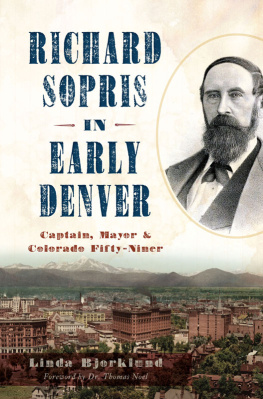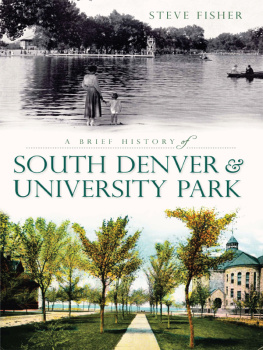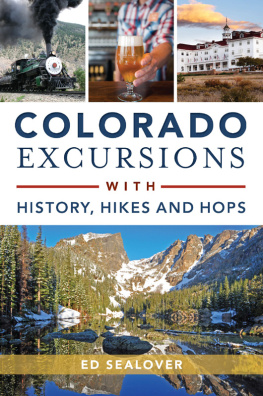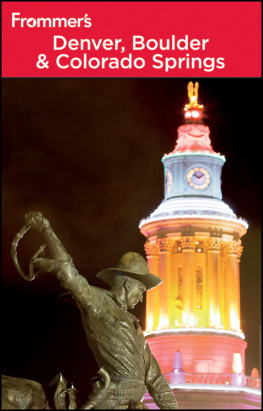


Published by The History Press
Charleston, SC
www.historypress.net
Copyright 2016 by Linda Bjorklund
All rights reserved
First published 2016
e-book edition 2016
ISBN 978.1.43965.693.8
Library of Congress Control Number: 2016931934
print edition ISBN 978.1.46713.593.1
Notice: The information in this book is true and complete to the best of our knowledge. It is offered without guarantee on the part of the author or The History Press. The author and The History Press disclaim all liability in connection with the use of this book.
All rights reserved. No part of this book may be reproduced or transmitted in any form whatsoever without prior written permission from the publisher except in the case of brief quotations embodied in critical articles and reviews.
Foreword
In May 2011, CU-Denver History Professor Tom Noelknown locally as Dr. Colorado for his research, teaching, tours and writings about the history of the Highest Statesubmitted to the Denver Post a column with the title Denvers next mayor has big shoes to fill. In the article, Dr. Noel listed five former Denver mayors he reckoned to be the citys top mayors throughout its history. The first one listed was Richard Sopris, mayor from 1878 to 1881.
Sopris first championed Denvers now superb park system and is commemorated by Sopris Gate at City Park. A Pennsylvania farm boy who became a Mississippi riverboat pilot and also built submarines, Sopris joined the 1859 gold rush to Colorado. He helped establish Glenwood Springs and is honored by nearby Mount Sopris. Captain Sopris also helped found the Society of Colorado Pioneers, an ancestor of todays History Colorado.
Asked to comment on Richard Sopris in Early Denver: Captain, Mayor & Colorado Fifty-Niner, Dr. Noel responded:
Richard Sopris was a part of the history of the State of Colorado and the City of Denver, usually in the thick of things or at least on the edge of things as one of the first gold miners and explorers, then as Mayor of Denver from 18781881 and then as Denvers pioneer park commissioner. Linda Bjorklunds book delves into the details of this fascinating and ubiquitous, but underappreciated pioneer crucial to Colorado and its capital city.
Preface
This book is so much more than the history of one man, Captain Richard Sopris. Ms. Bjorklund researched, gathered and discovered so many facets and stories of early Denver, Colorado, and national events of the times about which she wrote that she managed to weave a wonderful historical story of the life and times of Captain Sopris. Our family shall ever be grateful to Linda for putting our ancestors life into words for us all to relish.
MARGARET (PEG) FARRINGTON HULSEY
Great-great-great-granddaughter of Richard Sopris
From Yardley to Michigan City
Richard Sopris was born in Yardley, Bucks County, Pennsylvania, on July 26, 1813, son of James and Mary Sopris. William Penn, founder of the state of Pennsylvania, named the county after Buckinghamshire, his home county in England. Bucks County was one of the three original counties in the American colony.
The town of Yardley is situated a few miles from the Delaware River and not too far from Philadelphia. This is where George Washington crossed the Delaware on Christmas Day 1776. Washingtons troops had been defeated by the British at several locations, and morale was at a low ebb. Thomas Payne was prompted to write, These are the times that try mens souls. Washington had taken his men to the Pennsylvania side of the Delaware River to regroup in an area near the town of Yardley. The Hessians, Germans hired by the British, were camped in Trenton, New Jersey, on the opposite shore of the Delaware and had been celebrating their military victories, as well as Christmas Day festivities. Washington loaded a number of freight haulingtype boats with his troops, and during the frigid night, they quietly made their way across the river. The plan was to disembark on the New Jersey side of the river and flank the Hessians from both the north and south of their camp to overcome them, which the Americans successfully accomplished. The victory provided a well-needed boost to the morale of the patriot soldiers.

Richard Sopris. Courtesy of the Farrington family.
Richard Sopris grew up here and worked on his fathers farm until he was sixteen years old. He then began to learn the trade of house carpenter. He met Elizabeth Allen, a descendant of the patriot Ethan Allen, in Trenton and married her on June 5, 1836. The couple moved to Brookville, Indiana, where Sopris became a contractor on the Whitewater Canal.
Canal building has been going on since humans decided they needed to travel and found floating on a waterway much easier than walking or urging a horse along a rough path. Earliest canals were depicted on clay tablets, showing short waterways connecting to the Euphrates River in ancient Mesopotamia.
In the United States, having won the Revolutionary War, citizens began to look inward for ways to connect with one another. Numerous waterways prompted notables like George Washington to organize the building of canals to encourage commerce in the young nation. The success of early canal building led to a major undertaking across the state of New York.
Pioneers had moved westward and settled along the banks of the Great Lakes. They were able to establish a lucrative trade with Canadians but were prohibited from dealing with their own countrymen on the East Coast because of the difficult path across the Appalachian Mountains. Those coming into New York Harbor found the going easy up the Hudson River until they reached Albany. What forward-looking enthusiasts envisioned was a waterway system that connected Albany with Buffalo, located on the banks of Lake Erie.
It took nearly nearly nine years of construction to complete the canal, but in 1825, when it was ready to be used, New York Governor DeWitt Clinton boarded a vessel named the Seneca Chief in Buffalo. The vessel made its way to New York City carrying a cask of Lake Erie water, which the governor poured into New York Harbor. This was the momentous opening of the Erie Canal.
Success of the Erie Canal prompted state governments in Ohio and Pennsylvania to build their own canal systems. The Ohio River flows out of Pennsylvania westward, forming the southern boundaries of the states of Ohio and Indiana and the southeastern boundary of Illinois. The Ohio River meets and flows into the Missouri River at the southern tip of central Illinois.

Erie Canal. Drawing by Angie Hopkins.
The State of Indiana was eager to share in the wealth created by the canal systems. Its neighboring State of Ohio had built two major canal systems, the Ohio-Erie and the Miami-Erie. The Ohio-Erie connected Lake Erie at Cleveland with the Ohio River at Portsmouth. The Miami-Erie connected Lake Erie at Toledo to the Ohio River at Cincinnati. Engineers in the state of Indiana proposed two canal systems. The Wabash and Erie Canal was to connect with the Miami-Erie in Ohio and follow the Wabash River westward across the state of Indiana, veering southward as it flowed into the Ohio River. The Whitewater Canal was to extend southward from Hagerstown in eastern Indiana along the Whitewater River, through Brookville, flowing into the Ohio River at Lawrenceburg.
Next page












